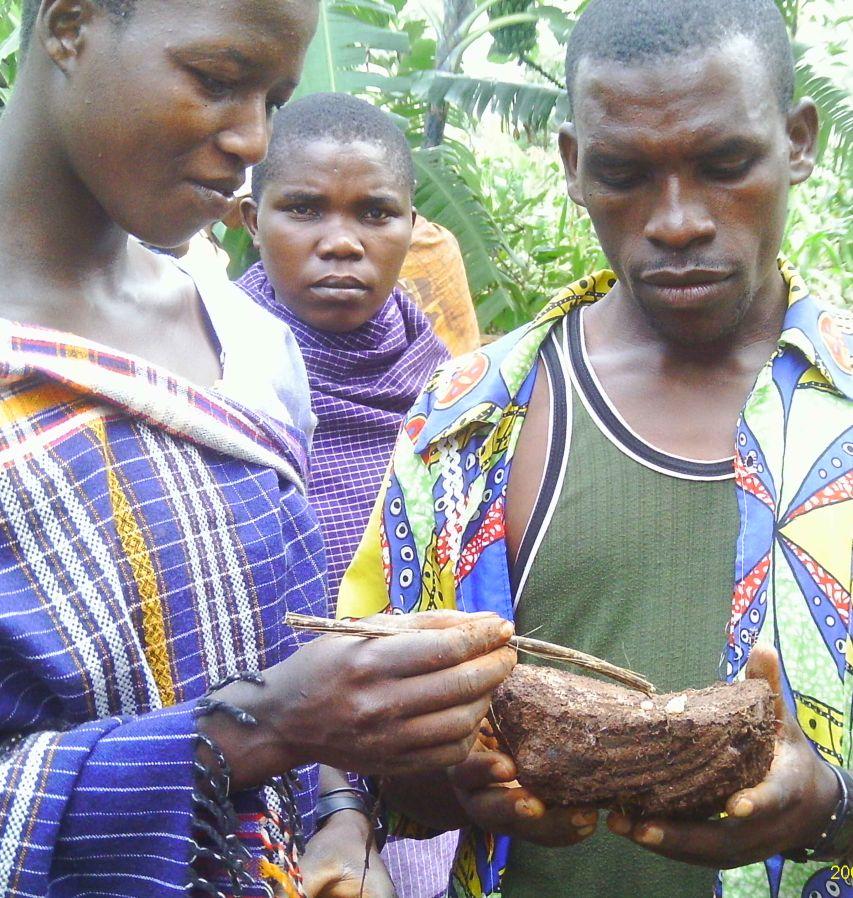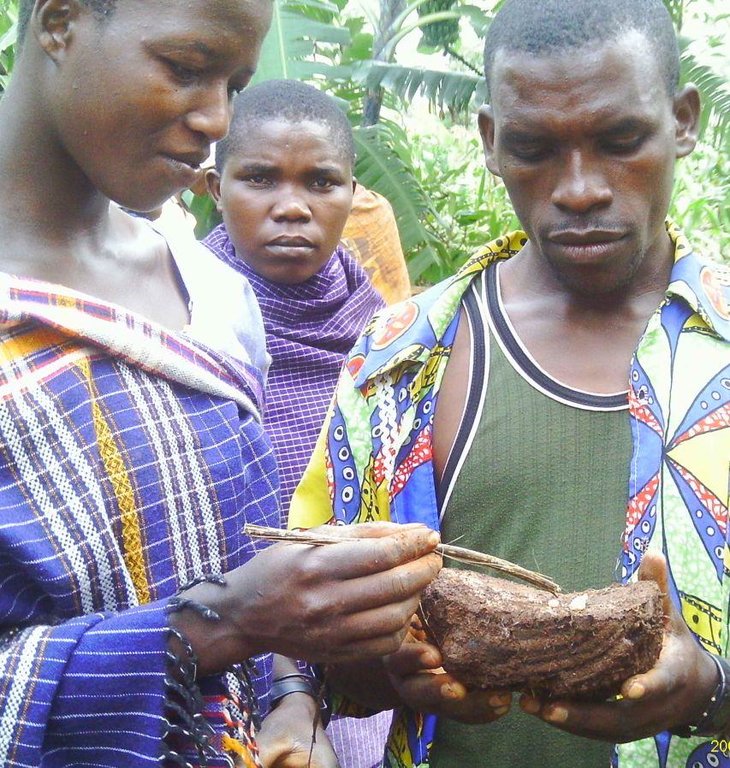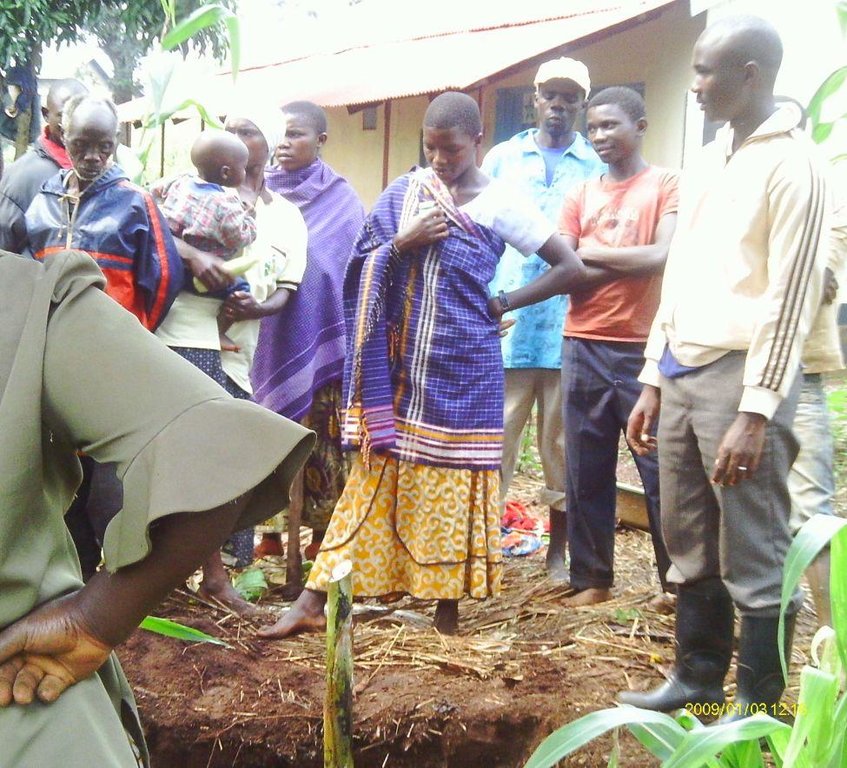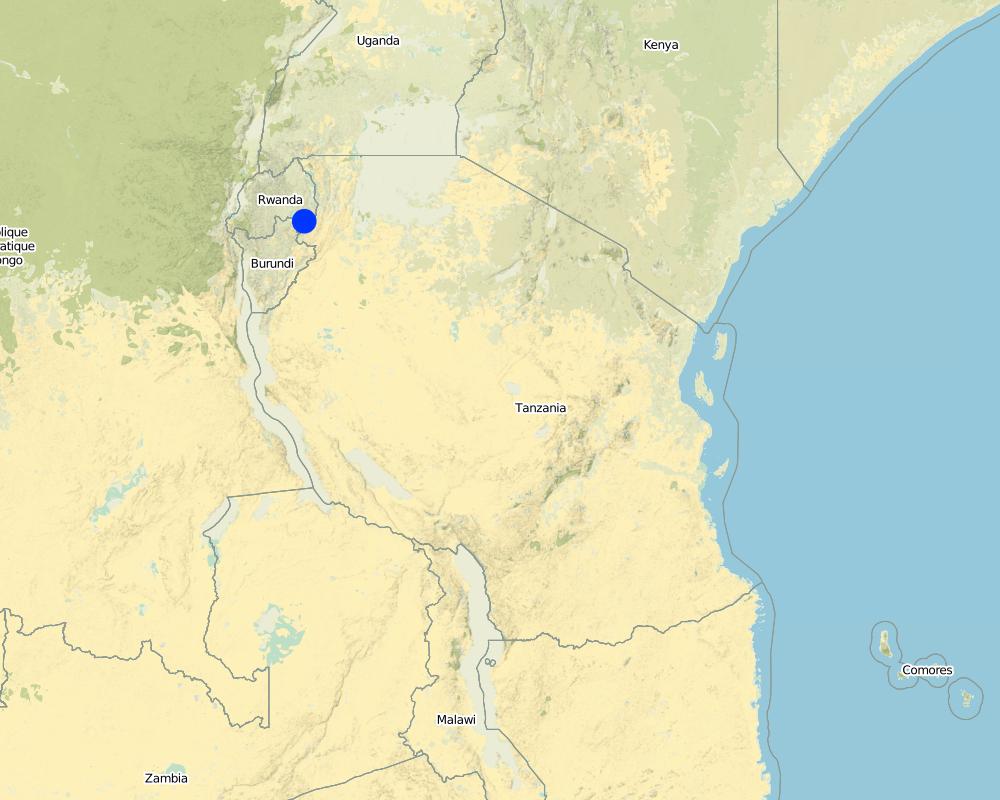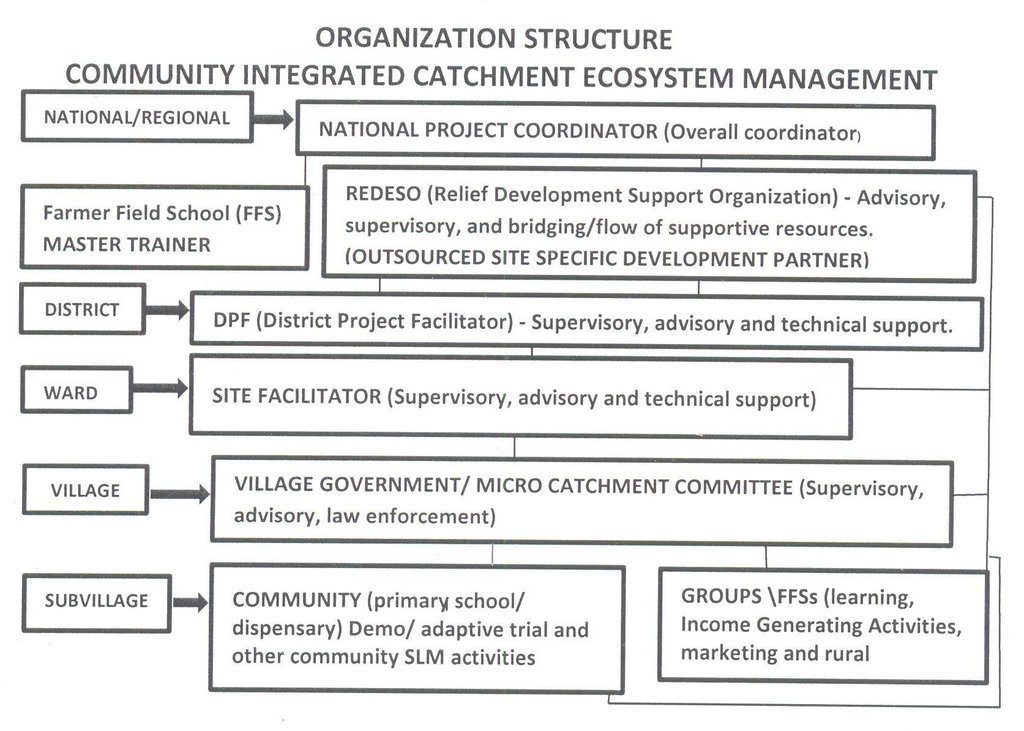Community intergrated catchment ecosystem management [República Unida da Tanzânia]
- Criação:
- Atualização:
- Compilador/a: ALLAN BUBELWA
- Editor: –
- Revisor: Fabian Ottiger
Mfumo wa usimamizi wa ekolojia katika eneo bonde (Swahili)
approaches_2486 - República Unida da Tanzânia
Veja as seções
Expandir tudo Recolher tudo1. Informação geral
1.2 Detalhes do contato das pessoas capacitadas e instituições envolvidas na avaliação e documentação da abordagem
Especialista em GST:
Especialista em GST:
Especialista em GST:
Mwasikundima Idephonce
Ngara District Council
República Unida da Tanzânia
Nome da(s) instituição(ões) que facilitou(ram) a documentação/avaliação da Abordagem (se relevante)
Bukoba district council (Bukoba district council) - República Unida da TanzâniaNome da(s) instituição(ões) que facilitou(ram) a documentação/avaliação da Abordagem (se relevante)
Ngara District Council (Ngara District Council) - República Unida da Tanzânia1.3 Condições em relação ao uso da informação documentada através de WOCAT
Quando os dados foram compilados (no campo)?
10/03/2014
O/a compilador/a e a(s) pessoa(s) capacitada(s) aceitam as condições relativas ao uso de dados documentados através da WOCAT:
Sim
1.4 Referência ao(s) questionário(s) sobre tecnologias da GST
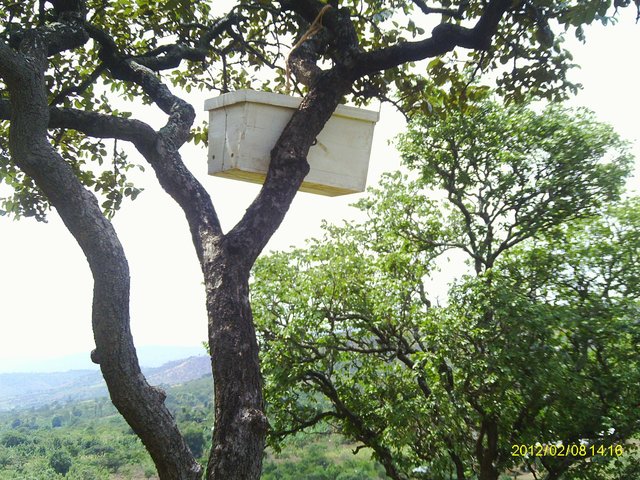
Natural forest conservation using apiaries [República Unida da Tanzânia]
Establishment of apiaries in natural forests to retard forest mismanagement and improve honey production
- Compilador/a: Philip Ileta
2. Descrição da abordagem de GST
2.1 Descrição curta da abordagem
Adaptive Agro-ecosystem Micro-catchment Approach.
2.2 Descrição detalhada da abordagem
Descrição detalhada da abordagem:
Aims / objectives: SLM knowledge skill generation and capacity building. Improved group and community strength, sustainability, organization and their capacity to benefit and invest in SLM. Motivation of community participation in SLM through use of quick win project, income generating activities, rural micro finance institutions, marketing and active engagement of disadvantaged groups.
Methods: Wider promotion of basket of choice of SLM technologies through SLM Farmer Field School, Demonstration plots and community related activities. Make use and build on already existing and new groups, existing institutions and the community as a whole. Strategic use of easily available and accessible available community institutions/ infrastructures (school and dispensaries sites) to demonstrate and promote basket of choice of SLM technologies. Learning by doing on the job, practical training, adoption and adaptation to local reality.
Stages of implementation: Site characterization through land degradation analysis (LADA) and development of community site specific SLM plan exemplifying SLM interventions needed to address the identified degradation types. Set up and identification of approaches needed to execute identified interventions complementary approaches. Sensitization and awareness creation to the community and actual execution of approaches.
Role of stakeholders: Individual groups: are core implementers and potential beneficiaries of the project.
Extension worker: Advisory and technical backstopping.
Elected and employed leaders at the sub-village, village and ward level: bylaw/law enforcement, supervisory and land provision.
Relief for Development Societies NGO (REDESO): Service provision and development partner in SLM.
Trans boundary Agro-ecosystem Management Project (TAMP): Provision of supportive resources (financial and technical).
Ngara district council: Supervisory, technical, policy interpretation, monitoring and evaluation, documentation, analysis and shairing .
Rugenge/Kirusha Micro catchment Committee: Supervisory, advisory and law enforcement.
2.3 Fotos da abordagem
2.5 País/região/locais onde a abordagem foi aplicada
País:
República Unida da Tanzânia
Região/Estado/Província:
Tanzania
Especificação adicional de localização:
Ngara
Map
×2.6 Datas de início e término da abordagem
Indique o ano de início:
2010
Ano de término (caso a abordagem não seja mais aplicada):
2014
2.7 Tipo de abordagem
- Baseado em projeto/programa
2.8 Principais metas/objetivos da abordagem
The Approach focused mainly on SLM with other activities (Motivating quick win income generation activities, rural microfinance institutions, marketing and HIV/AIDS controll.)
Knowledge/skill generation, demonstration and sustainability of SLM activities.
Motivate active participation of the community.
Inculcate a sense of community ownership/ community take charge of SLM activities.
The SLM Approach addressed the following problems: Lack of technical knowledge
Low investment capacity
Malpractice and mismanagement of local resources (e.g. fire burning, ploughing along the slope).
Adequate supervision, monitoring and law enforcement.
2.9 Condição que propiciam ou inibem a implementação de tecnologia/tecnologias aplicada(s) segundo a abordagem
Normas e valores sociais/culturais/religiosos
- Inibitivo
Negative cultural believes that fire burning can lead to one living long or reach older age.
Treatment through the SLM Approach: Change of mind set through FFS training, demos and community sensitization.
Disponibilidade/acesso a recursos e serviços financeiros
- Inibitivo
Low investment capacity and inability to access supportive resources
Treatment through the SLM Approach: Easy access to TAMP supportive resources.
Quadro institucional
- Inibitivo
Narrow coverage of the district, local institutions not involved in in SLM.
Treatment through the SLM Approach: Higher coverage, ope-rationalization of SLM in LGA system.
Quadro jurídico (posse de terra, direitos de uso da terra e da água)
- Propício
The existing land ownership, land use rights / water rights helped a little the approach implementation: Hindrance is usually observant for approaches which need long term commitment of land resources (e.g perennial crops) but is minimal for short term (annuals and biannual).
Open access land resources are difficult to manage.
- Inibitivo
Reluctance of the village to issue land, less protection of open access land resources.
Treatment through the SLM Approach: land issuing for FFS/Demo use legally recognized through signing of Memorandum Of Understanding (MOU) between the village and land users/SLM groups. Bylaws reinforcement to protect mismanagement of open access land resources.
Conhecimento sobre GST, acesso a suporte técnico
- Inibitivo
Inadequate understanding and use of SLM technical knowledge (both scientific and indigenous) to address land degradation problems.
Treatment through the SLM Approach: Up scaling use of scientific SLM knowledge.
Documentation, evaluation, analysis and sharing of successful indigenous SLM technical knowledge.
Carga de trabalho, disponibilidade de força de trabalho
- Inibitivo
High workload to extension officers (due to their shortage).
Treatment through the SLM Approach: Build a local resource base in facilitating SLM activities through introduction of community SLM facilitators and Micro-catchment committee.
Outro
- Inibitivo
Low motivation due to long term realization of SLM benefits.
Treatment through the SLM Approach: introduce SLM related quick win projects and income generation activities (IGA).
3. Participação e papel das partes interessadas envolvidas
3.1 Partes interessadas envolvidas na abordagem e seus papéis
- Usuários de terra/comunidades locais
Core implementors. all gender, youth and elders . Widows, Orphans, People living with HIV/AIDS were actively indiscriminately involved in FFS, Demos and community related activities..
- Especialistas em GST/ consultor agrícola
all gender, youth and elders
- Professores/alunos/estudantes
all gender, youth and elders
- Organização não governamental
dvisory, technical back stopping, supervisory and monitoring.
- Governo local
Advisory, technical back stopping, supervisory and monitoring.
- Governo nacional (planejadores, responsáveis pelas decisões)
dvisory, technical back stopping, supervisory and monitoring.
- Organização internacional
dvisory, supervisory and monitoring.
Caso várias partes interessadas foram envolvidas, indique a agência líder:
Land user (all genders, youth and elders): consulted and made informed decision about the approach to be used. National specialists: potential facilitators in designing and community sensitization. International specialists: consultative and subject matter specialist (e.g. FFS specialist)
3.2 Envolvimento do usuários de terra/comunidades locais nas diferentes fases da abordagem
| Envolvimento do usuários de terra/comunidades locais | Especifique quem estava envolvido e descreva as atividades | |
|---|---|---|
| Iniciação/motivação | Passivo | Community, groups, employed and elected leaders: participated in sensitization and awareness creation process. |
| Planejamento | Participativo | Community, groups, employed and elected leaders: active participants and decision makers in planning e.g. selection of FFS community facilitators and formation of micro-catchment committee. |
| Implementação | Apoio externo | Community, groups, employed and elected leaders: core and key implementers of the approach. |
| Monitoramento/avaliação | Participativo | Community, groups, employed and elected leaders: self mobilized and client interactive monitoring. |
| Research | Participativo | Community, groups, employed and elected leaders: site identification and active implementers of adaptive trials (e.g use of fanya juu/chini terraces, vertivar grass e.t.c). Adopters, users and promoters of the best bets technologies. |
3.3 Fluxograma (se disponível)
Descrição:
organization structure of community integrated catchment ecosystem management.
Autor:
Allan Isaka Bubelwa (Box 38 Kyaka Missenyi Kagera Tanzania)
3.4 Decisão sobre a seleção de tecnologia/tecnologias de GST
Especifique quem decidiu sobre a seleção de tecnologia/tecnologias a serem implementadas:
- Principalmente usuários da terra, apoiados por especialistas em GST
Explique:
Land users working in collaboration with SLM specialist through a participatory dialogue and decision making process.
Decisions on the method of implementing the SLM Technology were made by mainly by land users supported by SLM specialists. During inception of the project, land users were actively involved in deciding on the type of method to adopt e.g. selection of site and test crops for FFS, Demo and community related SLM activities.
4. Suporte técnico, reforço das capacidades e gestão do conhecimento
4.1 Reforço das capacidades/ formação
Foi oferecida formação aos usuários da terra/outras partes interessadas?
Sim
Especifique quem foi capacitado:
- Usuários de terra
- Equipe de campo/consultores
- employed and elected leaders
Caso seja relevante, especifique gênero, idade, status, etnia, etc.
Both gender, all age (youth and elders)
Tipo de formação:
- Em exercício
- Agricultor para agricultor
- Áreas de demonstração
Assuntos abordados:
SLM related subjects
4.2 Serviço de consultoria
Os usuários de terra têm acesso a um serviço de consultoria?
Sim
Especifique se foi oferecido serviço de consultoria:
- nas áreas dos usuários da terra
Descreva/comentários:
Name of method used for advisory service: Farmer field schools (FFS); Key elements: Practical training and learning by doing., Basket of choice of Technologies/Demos., Group oriented and site specific; Adoption depends on farmers choice and ability to invest.
Advisory service is inadequate to ensure the continuation of land conservation activities; There is limited knowledge and low funding capacity.
4.3 Fortalecimento da instituição (desenvolvimento organizacional)
As instituições foram fortalecidas ou estabelecidas através da abordagem?
- Sim, moderadamente
Especifique a que nível (níveis) as instituições foram fortalecidas ou estabelecidas:
- Local
Especifique o tipo de apoio:
- Reforço das capacidades/ formação
Dê mais detalhes:
Training provision to micro-catchment committee.
4.4 Monitoramento e avaliação
Monitoramento e avaliação são partes da abordagem?
Sim
Comentários:
bio-physical aspects were ad hoc monitored by project staff, government, land users through observations; indicators: hactarage conserved
bio-physical aspects were ad hoc monitored by project staff, government, land users through measurements; indicators: hactarage conserved
technical aspects were regular monitored by project staff, government, land users through observations; indicators: number of adopters
technical aspects were regular monitored by project staff, government, land users through measurements; indicators: number of adopters
socio-cultural aspects were regular monitored by project staff, government, land users through observations; indicators: % involvement of women
socio-cultural aspects were regular monitored by project staff, government, land users through measurements; indicators: % involvement of women
economic / production aspects were regular monitored by project staff, government, land users through observations; indicators: % increase in yield and income
economic / production aspects were regular monitored by project staff, government, land users through measurements; indicators: % increase in yield and income
area treated aspects were regular monitored by project staff, government, land users through observations; indicators: hactarage conserved
area treated aspects were regular monitored by project staff, government, land users through measurements; indicators: hactarage conserved
no. of land users involved aspects were regular monitored by project staff, government, land users through observations; indicators: number of adopters
no. of land users involved aspects were regular monitored by project staff, government, land users through measurements; indicators: number of adopters
management of Approach aspects were regular monitored by project staff, government, land users through observations; indicators: Number of FFS, Demos and IGA
management of Approach aspects were monitored through measurements; indicators: umber of FFS, Demos and IGA
There were several changes in the Approach as a result of monitoring and evaluation: Introduction of FFS farmer facilitators and Micro-catchment committees.
There were few changes in the Technology as a result of monitoring and evaluation: In the course of implementation adjusting or modifying technologies to suit agro-ecological condition or landforms
4.5 Pesquisa
A pesquisa foi parte da abordagem?
Sim
- adaptive SLM trials
Dê mais detalhes e indique quem realizou a pesquisa:
Adaptive SLM trials run by community/district/ARI Maruku through demos where farmers can select the best bets to apply and try on their own fields.
Research was carried out on-farm
5. Financiamento e apoio material externo
5.1 Orçamento anual para o componente de GST da abordagem
Caso o orçamento exato seja desconhecido, indique a faixa:
- 10.000-100.000
Comentários (p. ex. principais fontes de recursos/principais doadores):
Approach costs were met by the following donors: international (TAMP): 50.0%; government (Region/ARI Maruku.): 10.0%; local government (district, county, municipality, village etc) (Ngara district council, Villages and Ward): 20.0%; local community / land user(s) (Local community and groups withi the microcatchment ): 20.0%
5.2 Apoio financeiro/material concedido aos usuários da terra
Os usuários da terra receberam apoio financeiro/material para a implementação de tecnologia/tecnologias?
Sim
5.3 Subsídios para entradas específicas (incluindo mão-de-obra)
- Equipamento
| Especifique quais entradas foram subsidiadas | Em que medida | Especifique os subsídios |
|---|---|---|
| Ferramentas | Totalmente financiado | Working gears (gun boots, raincoats, T-shirts) |
| Computers, cameras | Totalmente financiado | |
- Agrícola
| Especifique quais entradas foram subsidiadas | Em que medida | Especifique os subsídios |
|---|---|---|
| Sementes | Parcialmente financiado | |
| Fertilizantes | Parcialmente financiado | |
| Manure | Parcialmente financiado | |
- Outro
| Outros (especifique) | Em que medida | Especifique os subsídios |
|---|---|---|
| Livestock | Totalmente financiado | Chicken, goats and bees |
Se a mão-de-obra pelos usuários da terra foi uma entrada substancial, isso foi:
- Voluntário
Comentários:
labour was largely voluntarily and was rewarded indirectly by introduction of income generating activities.
Some inputs were fully financed, partly financed and not financed. Materials fully financed are those not available at the site or not adequately available or in shortage.
5.4 Crédito
Foi concedido crédito segundo a abordagem para atividades de GST?
Não
6. Análise de impactos e declarações finais
6.1 Impactos da abordagem
A abordagem auxiliou os usuários da terra a implementar e manter as tecnologias de GST?
- Não
- Sim, pouco
- Sim, moderadamente
- Sim, significativamente
Knowledge and skill acquired through FFS, Demos and community related intervention played significant role in improvement of SLM. Bylaw reinforcement significantly prevented malpractices/land resource mismanagement.
A abordagem concedeu autonomia aos grupos social e economicamente desfavorecidos?
- Não
- Sim, pouco
- Sim, moderadamente
- Sim, significativamente
Improved to livelihood mechanism/alternates to widow, orphan and people living with HIV/AIDS
A abordagem melhorou as questões de posse de terra/diretos do usuário que inibiam a implementação das tecnologias de GST?
- Não
- Sim, pouco
- Sim, moderadamente
- Sim, significativamente
The approach involve signing of memorandum of understanding (MOU) over use of land resource between farmer groups running Demos and FFS and the village government. MOU is a strong and reliable legal acquisition of land resource to be used for conservation activities.
Did other land users / projects adopt the Approach?
- Não
- Sim, pouco
- Sim, moderadamente
- Sim, significativamente
On average each FFS member induced adoption to 2 household farmers.
Did the Approach lead to improved livelihoods / human well-being?
- Não
- Sim, pouco
- Sim, moderadamente
- Sim, significativamente
Diversification of income sources through introduction of Quick win income generating (IGA) AND
Did the Approach help to alleviate poverty?
- Não
- Sim, pouco
- Sim, moderadamente
- Sim, significativamente
Improvement of livelihood alternates and income, the situation is improve in the future.
6.2 Principal motivação dos usuários da terra para implementar a GST
- Produção aumentada
increased production to meet daily needs and surplus for selling.
- Lucro (lucrabilidade) aumentado, melhora da relação custo-benefício
increased surplus and income accrued through surplus generation.
- well-being and livelihoods improvement
food security and income is the first priority.
6.3 Atividades de sustentabilidade de abordagem
Os usuários da terra podem manter o que foi implementado através da abordagem (sem apoio externo)?
- Sim
Caso afirmativo, descreva como:
Farmers have realized the benefit of SLM. The village historical track records and experience indicate that farmers in Kirusha village usually continue what ever they come to realize is implemented for their own benefit. Further more, establishment of local human resource in SLM in terms of FFS facilitators and micro-catchment committee and their ope-rationalization into LGA systems is an assure way towards sustainability.
Motivation induced through quick win income generating activities (goat production, chicken, piggery, fruit tree nurseries and apiaries) and easy to manage demo set at Kirushya primary school and dispensary (reachable and easily accessible) are added assurance for project sustainability.
6.4 Pontos fortes/vantagens da abordagem
| Pontos fortes/vantagens/oportunidades na visão do usuário da terra |
|---|
| Learning and acquisition of knowledge (How to sustain/ enhance this strength: continuation of FFS, Demo and community activities.) |
| Cohesiveness and self help (How to sustain/ enhance this strength: Continue promotion of VICOBA and Market. ) |
| Spread of knowledge within and outside village. (How to sustain/ enhance this strength: Continue use of the approach. ) |
| Pontos fortes/vantagens/oportunidades na visão do/a compilador/a ou de outra pessoa capacitada |
|---|
| Improved relationship, unity, cohesiveness and common voice. (How to sustain/ enhance this strength: Continue with promotion, strengthening and establishment of IGA, SACCAS and VICOBA.) |
| More farmers are involved (rapid adoption and expansion) (How to sustain/ enhance this strength: Up scaling and strengthening of FFS, Demos, and IGA. ) |
| The approach is cost effective (benefit surpass costs) (How to sustain/ enhance this strength: Promote, expand and continue use of FFS, Demos and IGA.) |
| Assured and promising elements of sustainability. (How to sustain/ enhance this strength: Strengthen ope-rationalization and use of micro-catchment committee and FFS facilitators. ) |
|
Easy access to supportive resources (Land and financial) (How to sustain/ enhance this strength: strengthen and liaise FFS with service providers (Bank, SACCOS and Marketing)) |
6.5 Pontos fracos, desvantagens da tecnologia e formas de superá-los
| Pontos fracos/desvantagens/riscos na visão do usuário da terra | Como eles podem ser superados? |
|---|---|
|
Negative customs and believes (it is believed that one can live longer and reach older age by setting fire and burning of a large area). |
Discourage negative custom and believes |
| Reluctance of household heads especially in patrimonial societies. | Community sensitization to gender (gender be addressed as the basic component of the approach). |
| Failure and negative experience of past development projects and programmes. | Change of mind set |
| Shortage of inputs and working facilities | Promote availability and accessibility of inputs and working facilities. |
| Pontos fracos/vantagens/riscos na visão do/a compilador/a ou de outra pessoa capacitada | Como eles podem ser superados? |
|---|---|
| Selfishness, individualism by some untrustworthy politicians and leaders. | Combine SLM promotion with civic education training. |
| Prone to natural calamities and disastrous events | Introduce and strengthen use of Agro-based insurance. |
| Largely relies on government or farmer willingness to release and offer land. | Sensitize and encourage use of MOU. |
| If not done in precaution can perpetuate dependency syndrome | Encourage use of self mobilized farmer groups and their strengthening and ope-rationalization into existing systems. |
| Reliable external supportive resource needed initially | Reliable and timely supply of supportive resources. |
7. Referências e links
7.1 Métodos/fontes de informação
- visitas de campo, pesquisas de campo
- entrevistas com usuários de terras
7.2 Referências às publicações disponíveis
Título, autor, ano, ISBN:
Site characterization report: Kimamba Lyoba,
Links e módulos
Expandir tudo Recolher tudoLinks

Natural forest conservation using apiaries [República Unida da Tanzânia]
Establishment of apiaries in natural forests to retard forest mismanagement and improve honey production
- Compilador/a: Philip Ileta
Módulos
Não há módulos


